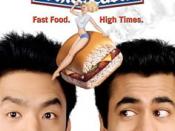Waiting for the Moment
People in cultures across the world congregate to local film theaters and purchase their tickets for the new popular film that everyone has been raving about. For two hours, strangers sit amongst each other in their seats with their eyes fixed upon the big screen all sharing the same feature. While the audience is equally presented with the same motion picture, each leaves with his or her own unique experience of the feature film. Spectatorship and the concept of how individuals alter, decontextualize and remobilize text within films has been an evolving and heavily concentrated area of study within film theory. One category of film that has attracted much attention within this theory is the text suggesting dominant racist ideology throughout the film. Using films with stereotypical texts allows the theory of spectatorship to be a much more objective and tangible issue to discuss. The concept of how a spectator of the race being stereotyped perceives and interprets the film suggesting a dominant racist ideology differs from a spectator not being of the race stereotyped is widely discussed in Peter Feng's article Recuperating Suzie Wong: A Fan's Nancy Kwan-dary. Feng examines how the film The World of Suzie Wong, which suggests many Asian American stereotypes, is a film that the Asian American loves to hate and loves to love. While this film conveys many Asian American stereotypes, a film such as Harold and Kumar Go to White Castle is a film that has a much broader range of stereotypes suggested within the text. Since no one is safe from being stereotyped within the text of Harold and Kumar Go to White Castle, this is an exceptional film in an attempt to understand how it is a film that the spectator loves to
2
love and loves to hate and how this attitude is constructed within different types of spectators.
Throughout Feng's article, he questions how a stereotypical film such as The World of Suzie Wong is found pleasurable within the very spectator of the dominant stereotypical ideology advocated within the film. He proceeds to propose that films that have a stereotypical dominant ideology are found pleasurable within the spectator because they take pleasure in either loving or hating the film. It's obvious on how the viewer can take pleasure in hating a film that stereotypes his or her own race or religion due to the fact that they are able to recontextualize the film and critique it, but how is it that someone can take pleasure in loving a film that stereotypes his or her own race or religion such as an Asian American spectator of The World of Suzie Wong? In order for someone such as an Asian American to find pleasure in this film, they must first acknowledge and be fully aware of the dominant racist ideology within the film in order to open up the closed text and enjoy it. Throughout the entire film, the spectator will love to hate it by critiquing and breaking down the stereotypes within it while simultaneously yearning for the desire to question the pleasure that they are feeling in an attempt to break free from it. Regardless of whether the viewer is currently loving to hate or loving to love the film, he or she consciously or subconsciously acknowledges the racist messages suggested within the film because it would be impossible to open up the text and find pleasure without doing this. In The World of Suzie Wong, Nancy Kwan's character is the passive submissive Asian American hooker with a heart of gold, an obvious stereotype within Asian American women in film. Throughout the film, Kwan's character is
3
submissive to the male lead, played by Robert Lomax. The Asian American spectator takes this and finds pleasure out of it by criticizing the absurdity of the stereotype throughout the entire film until suddenly, there is that one moment. This is the moment that the spectator waits patiently for throughout the entire film where the stereotyped character resists the dominant racist ideology illustrated by the film. The scene where Kwan's character acts as the empowered teacher taking charge and shows Lomax's character how to use the chopsticks is one of these moments from The World of Suzie Wong. In this isolated moment, the tables turn briefly and the spectator takes pleasure in savoring the moment that works against the text's dominant ideology. The entire narrative of the film suggests Kwan's character as the stereotypical Asian American women until this one moment where she breaks free and goes against the grain of this stereotype. The spectator is in a way constructing an entirely new narrative from making meaning out of these moments or bits and pieces from the text such as this one. The resistance within the protagonist in the film allows resistance within the spectator. It allows the spectator to mobilize these moments and use them to surpass the dominant ideology and create a new narrative logic; One in which stereotypes are not enforced but are instead refuted and disproved.
Like The World of Suzie Wong, Harold and Kumar Go to White Castle has a narrative consisting of a dominant stereotypical ideology. However, this film is more complex when it comes to the theory of spectatorship due to the larger amount of races and religions targeted for stereotypes. While The World of Suzie Wong stereotypes Asian American women, no one is safe from being labeled and generalized in Harold and
4
Kumar Go to White Castle. There still remain many similarities and differences between both films though. Like The World of Suzie Wong, the protagonist of Harold and Kumar Go to White Castle, Harold, is Asian American which allows the Asian American. There are also similar stereotypes within both protagonists within each film, specifically they both have shy, submissive characteristics. The major difference between the two films is the extent and amount of groups targeted for stereotypes. There are remarkably more groups victimized for stereotyping in Harold and Kumar Go to White Castle compared to The World of Suzie Wong. This discrepancy between films has many noticeable and important affects when it comes to establishing an attitude of loving to love and loving to hate the film within the spectator. Having more groups targeted with more blatant and absurd stereotypes allows for a wider range of people to relate and identify with the film which in turn intensifies the love hate relationship between the film and spectator. The film also has characters that resist absurd stereotypes which in comparison intensify the love to love relationship between the film and spectator. The protagonist in the film, Harold, played by John Cho represents the shy, compliant and hopeless romantic Asian American stereotype. Throughout the film he fuels and fulfills this stereotype in multiple scenes such as doing other people's work for them at work, passively getting harassed by the skater punks, not being able to hold a conversation with Maria and numerous other shy and passive stereotypes associated with Asian Americans. Like Kwan's character in The World of Suzie Wong, Harold has his moment where he gains the courage and stands up for himself and resists the dominant stereotypical ideology suggested throughout the entire film. Like with Kwan's character, this allows the Asian American spectator to use
5
this moment to resist the ideology of the film along with Cho's character creating a love to love standpoint toward the film. The problem with this is that only allowing the protagonist, who is Asian American, to resist the ideology and not allow any of the other characters being labeled and stereotyped to resist the ideology limits the amount of people that can relate to the film and are thus unable to get the love to love attitude toward the film that the Asian American spectator experiences.
On the other hand, there are characters in the film that resist the common stereotype attributed with their race or religion and then instead of having a resisting moment, experience an accepting moment and give into the dominant ideology. Kumar, Harold's friend, played by Kal Penn is a good example of this type of character. Throughout the entire film, Penn's character blows off interviews with med schools and is pressured by his father and brother, who are both doctors, to become a doctor also. Like the moment that Cho's character experiences that opens his eyes and allows him to withstand the dominant ideology, Penn's character goes through an exact opposite experience in which he gives into the dominant ideology of the stereotypical Indian doctor. While Cho's character more heavily induces a feeling of love to hate the film due to his consistent affirmation of the Asian American stereotype until his moment at the end where he resists, Penn's character in contrast induces a more heavily love to love relationship between the film and the spectator because of his consistent resistance to the stereotype usually associated with Indians until when he finally gives into the dominant ideology thus transforming the viewers attitudes to a love to hate attitude toward the film.
6
Films that imply certain stereotypes within groups of people share a distinct experience within the spectator when compared to other films. Whether the spectator has racist or anti-racist views, he or she will still be able to find the film pleasurable by either loving to hate or loving to love the film and this is true even with spectators of the group being stereotyped such as Asian American spectators of The World of Suzie Wong as described in Peter Feng's article Recuperating Suzie Wong: A Fan's Nancy Kwan-dary. However, with a film such as Harold and Kumar Go to White Castle, which leaves no group safe from stereotypical attack, the spectator has quite a different experience than viewing a film that solely focuses on one single group. Whether or not the spectator agrees or disagrees to the stereotypes being true has a large effect as to what aspects of the film they will either love to love or love to hate. A spectator who believes the stereotypes to be true that are conveyed in Harold and Kumar Go to White Castle would gain pleasure from the film for different reasons that a spectator who believes the stereotypes to be untrue. A spectator who agrees with the stereotypes conveyed would find pleasure in loving to love Harold throughout the entire film as he submits to the dominant ideology of the stereotypes and would love to hate the film when he has his moment and breaks free from the stereotypes instilled in the dominant ideology. On the other hand, with Kumar, this spectator would love to hate the film as Kumar resists the dominant stereotypical ideology labeled with Indians and would then love to love the film as he has his moment and gives into the stereotypical ideology that he was resisting throughout the entire film. These attitudes toward the film that are built within the spectator through each character as they progress throughout the film and have their
7
moment to either resist or submit would be the opposite for the spectator who finds the stereotypes untrue and erroneous but nevertheless, whether the spectator agrees or disagrees with the stereotype, he or she consciously or subconsciously acknowledges the stereotypes to be present within the film in order to establish these attitudes. The main determining factor for how the spectator perceives, interprets and feels about a film suggesting stereotypes is whether or not they believe the stereotypes to be true or false and this in turn will drive the spectator to either love to love or love to hate the majority of the film until that one turning point within the character, changing their attitudes from love to love to love to hate or vice versa.

![Harold Kantner Special Collection Photo [Photo]](https://s.writework.com/uploads/0/1766/harold-kantner-special-collection-photo-photo-thumb.jpg)
